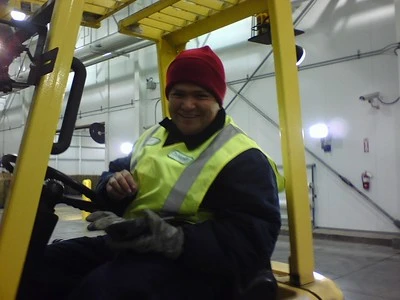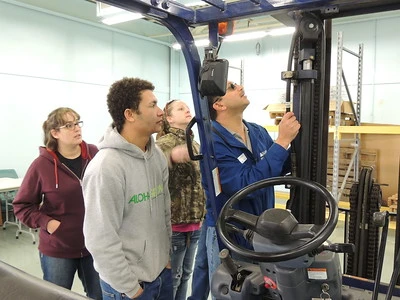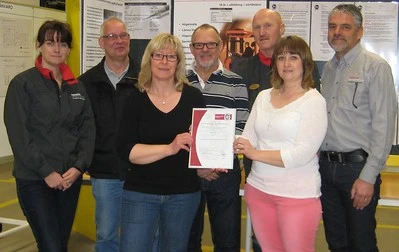Forklift Training For Beginners: (Things You Must Know)
May 22, 2024 | by onlineoshasafetytraining.com


A forklift is a powerful tool that helps move heavy things around easily, like big boxes or pallets, especially in places like warehouses, construction sites, and factories. It’s like a small truck but with metal forks in the front to lift and carry loads. Forklifts are super important because they make lifting and moving big items much faster and safer than doing it by hand.
In this article, we’re going to focus on teaching beginners how to drive and use forklifts the right way, so they can do their job safely and well. Whether you’re just starting out or need a little refresher, we’ve got you covered with all the basics you need to know.
The objective of the Beginner Forklift Training
- Safely Operate a Forklift:
- What You’ll Learn: You’ll get hands-on training on how to drive a forklift. This includes starting the forklift, steering it through tight spaces, and stopping it safely.
- Why It’s Important: Operating a forklift safely helps prevent accidents in the workplace, protecting both you and your colleagues. Proper driving techniques also help prevent damage to the forklift and the goods you’re transporting.

- Load and Stack Safely:
- What You’ll Learn: This part of the course teaches you how to properly lift and lower loads with the forklift. You’ll practice how to securely place items on the forklift, move them to a new location, and stack them neatly and safely, especially in storage racks.
- Why It’s Important: Safe loading and unloading minimize the risk of dropping goods, which can cause damage or injury. Proper stacking techniques ensure that stored items are stable and won’t fall, creating a safer work environment.
- Know the Rules:
- What You’ll Learn: You will be introduced to the specific laws and regulations that apply to forklift operation in your area. This includes workplace safety standards and the legal responsibilities of forklift operators.
- Why It’s Important: Knowing the legal requirements helps you comply with the law and ensures that you are operating the forklift within safety guidelines, which can protect you from legal issues and workplace penalties.
- Refueling and Maintenance:
- What You’ll Learn: You’ll learn how to safely refuel a gas-powered forklift or recharge an electric forklift. The course will also cover how to perform pre-use inspections to check things like brakes, tires, and hydraulic systems.
- Why It’s Important: Proper refueling and charging practices prevent accidents and fires. Regular inspections help identify potential problems before they cause accidents or costly breakdowns.
- Understand Forklift Limits:
- What You’ll Learn: You will learn about the lifting capabilities of forklifts, including how much weight they can safely carry and how this affects their balance and stability.
- Why It’s Important: Understanding the limits of your forklift prevents overloading, which can lead to tipping over. Knowing about stability helps you operate the forklift more safely, especially when turning or lifting loads to different heights.
- Know the Rules:
- What You’ll Learn: You will be introduced to the specific laws and regulations that apply to forklift operation in your area, focusing particularly on OSHA standards and any local laws specific to your state. This includes understanding workplace safety standards and the legal responsibilities of forklift operators.
- Why It’s Important: Staying updated with the current laws and regulations ensures compliance, helping you avoid legal issues and workplace penalties. Being knowledgeable about OSHA standards and local laws also enhances safety practices, which protect you and your colleagues from potential accidents and injuries.
By the end of this course, you’ll be equipped with the necessary skills to operate a forklift safely and effectively, keeping both you and your workplace safe.
You Need to Find a Forklift Training Provider If You Want To Take The Course
Steps to Find a Forklift Training Provider
- Research Local Training Centers:
- Start by searching online for forklift training providers near you. Use keywords like “forklift certification,” “forklift training near me,” or “forklift license training” to find local options.
- Check local trade schools, community colleges, and vocational training centers, as they often offer forklift training courses.

- Check for Accreditation:
- Ensure the training provider is accredited by relevant industry bodies or meets Occupational Safety and Health Administration (OSHA) standards. Accreditation is a sign of quality and compliance with safety regulations.
- Read Reviews and Testimonials:
- Look up reviews and testimonials from previous students. This can give you insights into the quality of training and the experiences of others.
- Ask for recommendations from colleagues or industry contacts who have undergone forklift training.
- Compare Training Programs:
- Evaluate what each training provider offers. Check the duration of the course, the topics covered, and whether they provide both theoretical and practical training.
- Some providers may offer additional services like job placement assistance or refresher courses.
- Verify Instructor Credentials:
- Check the qualifications and experience of the instructors. Experienced instructors can provide better insights and more effective training.
- An instructor with real-world experience in operating forklifts can offer practical tips and a deeper understanding of everyday challenges.
- Consider Cost and Schedule:
- Compare the costs between different training providers to find one that fits your budget. Don’t forget to inquire about any hidden fees such as materials or certification costs.
- Ensure the course schedule fits your availability. Some providers offer flexible schedules or weekend classes.
- Visit the Training Facility:
- If possible, visit the training facility to check out their equipment and training environment. This can help you gauge the quality of the training and the resources available.
- A well-maintained facility with up-to-date equipment reflects a commitment to providing professional training.
- Ask About Certification and Renewal:
- Ensure that the training ends with a recognized certification that is compliant with local laws and regulations. Ask about the process for certification and any exams involved.
- Inquire about how often you need to renew your certification and if the provider offers renewal courses.
By following these steps, you can find a forklift training provider that meets your needs and helps you gain the skills and certification required to operate a forklift safely and effectively.
Let’s Compare Trade Schools, Community Colleges, and Vocational Training Centers
| Feature | Local Trade Schools | Community Colleges | Vocational Training Centers |
|---|---|---|---|
| Types of Programs Offered | Specialized trade programs, including forklift training focused on specific industries like construction or warehousing. | Broader educational programs with a focus on long-term degrees, but also certificate programs like forklift training. | Highly specialized programs tailored to specific trades, including intensive forklift training. |
| Course Duration | Short-term courses, typically ranging from a few days to several weeks. | Varies widely; forklift courses might be part of a longer certificate program or offered as standalone short courses. | Short, intensive courses designed to quickly equip students with specific skills. |
| Cost | Can vary, often competitively priced due to the specialized nature of the training. | Generally affordable, with possible financial aid options for qualifying students. | Cost varies; often competitive with a focus on quick employment turnaround. |
| Facilities and Equipment | Modern and industry-specific equipment, often with state-of-the-art facilities due to partnerships with industries. | Good facilities, though equipment might be more general to accommodate a variety of programs. | Typically equipped with up-to-date, industry-standard equipment focused on practical skills. |
| Certification | Often provide industry-recognized certifications necessary for immediate job entry. | Certifications are usually part of broader educational credentials but are industry-recognized. | Focus on providing quick certification that meets industry and regulatory standards. |
| Flexibility | Flexible scheduling options to cater to working students or professionals looking for skill enhancement. | Offers part-time schedules, but more geared towards semester-based learning. | Highly flexible scheduling, often with options for weekend and evening classes. |
| Instructor Expertise | Instructors are typically seasoned industry professionals with direct experience in specific trades. | Instructors may be academically oriented with a mix of practical industry experience. | Instructors are often skilled tradespeople with current or recent industry experience. |
These Are What You Need to Enroll When You’re a Beginner
Eligibility and Requirements for Training for first time operators
- Who Can Undergo Forklift Training:

- Age Requirements: Generally, you must be at least 18 years old to undergo forklift training. This age requirement ensures that individuals are mature enough to handle the responsibilities that come with operating heavy machinery.
- Basic Qualifications: While specific educational qualifications may not be strictly necessary, it’s important to have basic literacy and numeracy skills. You should be able to read and understand training materials and safety instructions. Good physical condition is also crucial, as operating a forklift can be physically demanding.
- Prerequisites for Training:
- Medical Fitness: Some training programs require a basic medical check-up to ensure you are physically fit to operate a forklift. This might include checks on vision, hearing, and general physical fitness.
- Safety Training: Some employers or training programs might require you to complete a general safety training course before you can start forklift training. This helps ensure you have a foundational understanding of workplace safety.
- Certifications Needed Before Starting Training:
- No Prior Certifications Required: In most cases, you do not need any specific certifications before starting forklift training. The training program itself is designed to provide you with the necessary certification upon successful completion.
- License Requirements: While you don’t need a license to start training, you will need to obtain a forklift operator’s license or certification at the end of your training. This certification must be renewed periodically (the exact time frame can vary by location) to ensure you remain up-to-date with the latest safety protocols and regulations.
These requirements are designed to ensure that all forklift operators are well-prepared and qualified to handle the equipment safely and efficiently, minimizing the risk of accidents in the workplace.
Steps in Forklift Training
- Classroom Learning:
- What It Involves:
- Theory: You’ll start with classroom sessions where you’ll learn the theoretical aspects of operating a forklift. This includes understanding the mechanics of the forklift, the types of forklifts, and their applications in different industries.
- Safety Rules: Safety is crucial in forklift operation. The training will cover all necessary safety protocols, such as how to perform safety checks on the forklift, recognizing hazards, and the correct way to respond in emergency situations.
- Operation Guidelines: You’ll learn the standard operating procedures for forklifts, including how to start and stop the forklift, how to handle various loads, and navigating through typical workplace environments.
- What It Involves:
- Hands-On Training:
- What It Involves:
- Supervised Practice: After learning the basics in the classroom, you will move on to hands-on training. This part of the course allows you to operate a forklift under the supervision of an experienced instructor.
- Real-World Application: You’ll practice lifting, stacking, and moving loads in a controlled environment that simulates real workplace scenarios. This practical experience is crucial for building your confidence and competence with forklift operations.
- What It Involves:
- Evaluation:
- What It Involves:
- Written Test: The evaluation process usually begins with a written test. This test assesses your knowledge of the theory you’ve learned, including safety regulations and operational procedures.
- Practical Test: Following the written test, you’ll undergo a practical exam where you demonstrate your ability to operate the forklift safely and effectively. This includes performing various maneuvers, handling loads, and applying safety practices in real-time.
- Assessment of Readiness: The combined results of the written and practical tests will determine if you are ready to receive certification. Passing these tests confirms that you have the necessary skills and knowledge to operate a forklift safely.
- What It Involves:
These steps are designed to ensure that by the end of the training, you are fully prepared and certified to operate a forklift in a professional setting, prioritizing safety and efficiency.
It Might Take Longer Than Usual
It’s important to know that sometimes beginner forklift training might take longer than you expect. Here’s why:
- Comprehensive Coverage:
- What it Means: Forklift training is not just about driving. It includes a wide array of topics necessary for safe and efficient operation. This ranges from understanding the different types of forklifts (like sit-down riders, stand-up riders, reach trucks, and pallet jacks), to learning how each part of the forklift functions.
- Depth of Learning: Trainees must understand and comply with Occupational Safety and Health Administration (OSHA) standards, which dictate specific safety practices and operational procedures. Training also covers the physics of lifting and moving loads, including how weight distribution affects forklift stability.
- Practical Skills: Beyond theory, practical skills in navigating tight spaces, proper stacking techniques, and emergency handling are also taught, requiring detailed, step-by-step guidance to ensure mastery.
- Skill Variation:
- Individual Learning Pace: People have different learning speeds, especially when acquiring new physical skills. For someone with little to no experience in operating machinery, mastering the controls and movements of a forklift can take extra time.
- Adaptation to Equipment: Each forklift operates slightly differently, and adapting to these nuances is critical. Some might have more sensitive controls, different turning mechanics, or varied speed settings, all of which affect how quickly a trainee becomes proficient.
- Confidence Building: Confidence is key in operating a forklift safely. Training must ensure that each individual not only knows what to do but feels confident in their ability to do it under various circumstances.
- Safety First:
- Safety Over Speed: The primary goal of forklift training is safety. This means that courses are designed to repeat critical safety instructions and practice until they become second nature to the trainee. Rushing through these elements is not an option if safety is to be maintained.
- Risk Management: Understanding and managing risks in a dynamic environment such as a warehouse or construction site is crucial. Trainees learn to assess situations for potential hazards, a skill that requires time and experience to develop fully.
- Certification Requirements: To achieve certification, a trainee must demonstrate a range of competencies that encompass both knowledge and practical skills, proven through tests and evaluations that can extend training time.
- Updated Regulations and Standards:
- Keeping Current: Safety standards and operational regulations in the forklift industry are continually updated to reflect new safety research, technological advancements, and changes in work environments. Training programs must incorporate these updates, which can extend the length of training as new modules are added.
- Legal Compliance: Compliance with local, state, and federal laws is mandatory. As these laws evolve, training programs must adapt, sometimes increasing the breadth and depth of the curriculum to ensure all legal requirements are met comprehensively.
- Industry Best Practices: As best practices evolve, training must also evolve to include new techniques and technologies. This ensures that all operators are equipped with the most current and effective operational skills.
Remember, taking a bit more time to ensure you are fully prepared isn’t a setback—it’s an investment in your safety and competence on the job.
It May Cost Much More Expensive
The cost of forklift training can vary widely depending on several factors, including the location, duration of the course, type of forklift training, and the comprehensiveness of the program. Here’s a general breakdown of the price range you might expect:
- Basic Forklift Training:
- Cost Range: $100 to $200
- Details: This typically covers a short course (1-2 days) designed for beginners. It includes basic operation, safety procedures, and hands-on driving experience but might not cover advanced skills or different types of forklifts.
- Comprehensive Forklift Certification:
- Cost Range: $300 to $600
- Details: These courses are more extensive (up to 5 days or more) and are intended not only to teach basic skills but also more advanced techniques and operations on various types of forklifts. The higher cost reflects the additional time, more in-depth training, and the use of multiple forklift types.
- Specialized Forklift Training:
- Cost Range: $600 to $1,000 or more
- Details: Specialized training might include high-reach forklifts, rough terrain forklifts, or other specific equipment used in particular industries like construction or logistics. These courses are more technical, requiring specialized equipment and expert instructors.
- Refresher Courses:
- Cost Range: $50 to $150
- Details: These are shorter sessions designed to update existing operators on new regulations, refresh their skills, or re-certify after a period of inactivity. Prices are lower due to the shorter duration and more focused content.
- Corporate Training Packages:
- Cost Range: Prices vary widely; often negotiated on a case-by-case basis
- Details: Businesses seeking to train multiple employees can arrange for tailored training sessions that meet specific needs. These packages can include on-site training and may offer a per-person discount but generally involve additional costs for customization and convenience.
These costs typically include all necessary training materials and the certification fee, assuming the trainee passes the evaluation at the end of the course. However, additional costs might occur for things like application fees, exam retakes, or specific personal protective equipment required for training.
It’s important to note that while the upfront cost may seem high, the investment in proper forklift training is crucial for safety and compliance in the workplace, potentially saving costs associated with accidents and fines for non-compliance.
If You’re Employed, Your Employer Will Shoulder The Expenses
If you’re employed and required to operate a forklift as part of your job, it’s common for your employer to cover the expenses associated with forklift training. Here’s a breakdown of how this typically works and why it’s beneficial for both employees and employers:
Employer-Sponsored Forklift Training: What to Expect
- Coverage of Training Costs:
- What’s Included: Employers often pay for the entire cost of the training course, which can include tuition fees, certification fees, and sometimes travel expenses if the training center is not on-site.
- Reasons: This investment helps ensure that all operations involving forklifts are performed safely and in compliance with OSHA regulations, which mandate proper training and certification for forklift operators.
- Training During Work Hours:
- Paid Training Time: Many employers will allow you to take the training during regular work hours. This means you won’t have to use personal time or lose pay while attending training sessions.
- Scheduling Convenience: Employers might schedule training sessions in a way that minimizes disruption to normal business operations while still making it convenient for employees.
- Benefits to Employees:
- No Out-of-Pocket Costs: Employees can receive training without any direct financial burden, which can be a significant incentive.
- Enhanced Job Security: Being properly trained and certified not only complies with legal requirements but also enhances your skills and value as an employee, potentially leading to better job security and career advancement opportunities.
- Benefits to Employers:
- Reduced Liability: Properly trained forklift operators reduce the risk of workplace accidents, thereby lowering potential liability and the cost associated with workplace injuries.
- Increased Productivity: Well-trained operators are more efficient and can handle the forklift more effectively, which can lead to increased productivity and fewer errors or delays.
- Compliance with Regulations: Employers must comply with OSHA standards, which include ensuring that all forklift operators are competently trained. Compliance helps avoid fines and penalties.
- Ongoing Training and Recertification:
- Regular Updates: Forklift certifications are not indefinite; they typically need to be renewed every three years. Employers usually also cover the costs for recertification and any additional training needed due to changes in regulations or the introduction of new equipment.
If you are an employee who will be operating a forklift, it’s advisable to discuss training requirements and provisions with your employer. Most proactive employers will have a clear policy in place regarding the funding and scheduling of forklift training, ensuring all their operators are qualified and up-to-date with their skills and knowledge.
If You Have Been Trained in the Past and Did Not Gain Experience, You Need to Take the Beginner Forklift Training
If you’ve done forklift training before but haven’t really used a forklift much since then, it’s a smart idea to go through the beginner training again. Here’s why and what it involves:
Why Restart Beginner Forklift Training?
- Refreshing Your Skills: Forklift operations involve handling heavy loads with vehicles like counterbalance trucks or pallet jacks. If you haven’t been using these skills, you might need a refresher to get back up to speed.
- Safety Practices: Safety is crucial when operating a forklift. Beginner training revisits essential safety protocols like performing pre-operation checks and following the correct procedures for picking up, carrying, and setting down loads.
- Regulation Updates: The rules and regulations surrounding forklift operation, such as those set by OSHA (Occupational Safety and Health Administration), can change. Restarting training ensures you know the latest laws and best practices.
What Does Beginner Training Include?
- Theory Class: You’ll start in the classroom, learning or relearning the theory behind safe forklift operation, including the types of forklifts (e.g., high-reach forklifts, rough terrain forklifts), their components, and their capacities.
- Practical Training: You’ll get hands-on experience under supervision. This is where you practice the actual driving and handling of the forklift, performing tasks like lifting, stacking, and horizontal movement of loads.
- Evaluation: After the training, you’ll be tested with both written and practical exams to make sure you’re ready to operate a forklift safely. This might include tasks like navigating through a course or performing specific maneuvers.
Going back to beginner training will help make sure you’re both safe and competent on the job, even if you’ve learned it all before but haven’t practiced recently.
Conclusion
Wrapping up, if you’re just starting out with forklifts or getting back into it after a break, beginner forklift training is crucial. This training isn’t just about learning how to drive a forklift; it’s about doing it safely and effectively. During the course, you’ll learn all the must-knows about handling a forklift, from carrying loads safely to keeping an eye out for potential hazards in the workplace. Remember, operating a forklift is a big responsibility, and the skills you learn in training will help keep you and your coworkers safe. So, take your training seriously and approach every lesson with the goal to learn and improve.
RELATED POSTS
View all


